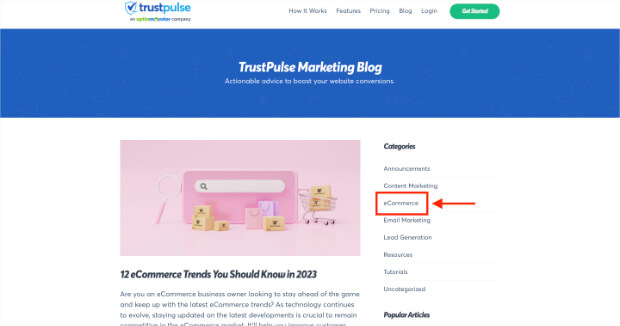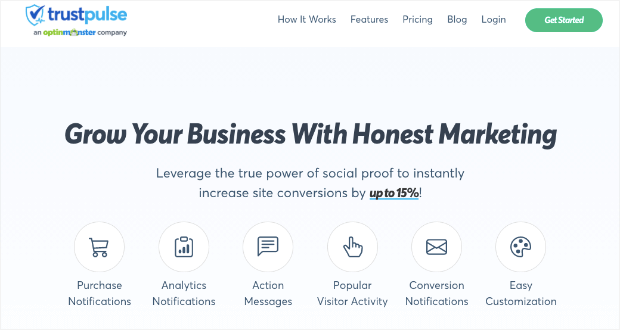Are you looking for ways to create a successful and profitable eCommerce brand that resonates with your audience?
In today’s competitive online marketplace, building a strong eCommerce brand is essential for the long-term success of your eCommerce business. It can help you stand out from the competition, increase customer loyalty, and drive sales.
In this article, we will share some practical ways to help you build (or rebuild) a brand that customers love and drive revenue for your business.
But first, let’s start with understanding what an “eCommerce brand” actually is.
- What Is an eCommerce Brand?
- Why Is It Important to Build an eCommerce Brand?
- 10 Ways to Create a Successful eCommerce Brand
- 1. Understand Your Market
- 2. Make Your Brand Stand Out
- 3. Build a Strong Brand Identity
- 4. Maintain Brand Consistency Throughout Your Business
- 5. Deliver Quality Products
- 6. Stay Updated With the Latest Trends
- 7. Diversify Your Content
- 8. Leverage Social Media
- 9. Take Advantage of Social Proof
- 10. Offer Exceptional Customer Service
- Build a Distinctive eCommerce Brand for Online Success
What Is an eCommerce Brand?

eCommerce has become an increasingly popular way to sell products and services online. According to stats, the eCommerce market is expected to total over $8.1 trillion by 2026. It shows that eCommerce is not just a passing trend but rather a valuable strategy that provides benefits over a long period.
Of course, as we know it today, it all began when retail giant Amazon created one of the first eCommerce websites in the early 1990s. And since then, numerous companies and entrepreneurs have followed its lead.
But, building a successful eCommerce business requires much more than setting up an online store.
An eCommerce brand is not just a logo, brand name, catchy tagline, and place to shop online. Your brand is the story of your online business, the values it represents, and how it’s perceived and talked about by your target market. It’s a unique identity that sets your eCommerce store apart from competitors. And even more, leaves a distinct impression about your products in the minds of consumers.
If you want to learn more, check out our Ultimate Guide to eCommerce.
Let’s look at some more reasons why building an eCommerce brand is crucial.
Why Is It Important to Build an eCommerce Brand?
Building an eCommerce brand is essential for various reasons beyond just having a unique identity. Here are some of the most compelling reasons why creating a strong eCommerce brand is crucial for business owners:
- Customer Retention: It can help increase customer retention rates by fostering a sense of loyalty and creating a positive association with your products or services. Customers who feel connected to your brand will likely return for repeat purchases.
If you want to learn more about customer retention, read our article What is Customer Retention? Customer Retention Strategies and Examples.
Don’t forget to explore the Best Customer Retention Tools that can help you keep more customers.
- Customer Acquisition: It can also help acquire new customers through word-of-mouth referrals, email marketing, content marketing, and other digital marketing strategies. Customers impressed by your brand are more likely to share their experience with others, which can help bring in new business.
Check out the list of Powerful Customer Acquisition Tools to Increase Profits.
- Better Customer Experience: A well-established brand can help create a better customer experience by providing consistency in your messaging, tone, and visual identity. This can help build trust with your potential customers and make them more likely to buy from you again.
- Flexibility: A strong brand can also provide flexibility in your business model. For example, suppose you decide to expand your product offerings or enter new markets. A strong brand can help you do so more easily by leveraging the trust and credibility you’ve built with your existing customer base.
Read our article on Ways to Build Credibility for Your Business.
- Increased Revenue: Ultimately, it can increase revenue by positively associating your products or services, leading to more sales and higher profit margins.
To increase your eCommerce sales and see results, read What is Customer Retention: Strategies and Examples.
Now that you know the significance of building a robust eCommerce brand, let’s explore the strategies to create a successful eCommerce brand.
10 Ways to Create a Successful eCommerce Brand
Whether you’re building your eCommerce brand from scratch or revising it, here are 10 strategies to attract your target customers and stand out from the competition:
1. Understand Your Market

Understanding your target audience and competition is crucial in building a solid eCommerce brand. This knowledge can help you create a more effective brand strategy and position your brand better in the marketplace.
Skipping this step may result in two possible outcomes:
First, you might end up with a brand that appears or sounds very similar to another existing company’s brand. Secondly, you may miss out on establishing your unique brand identity and effectively marketing your product or service.
Here are some questions you can ask yourself when conducting this research:
Questions regarding your potential customers
- Who are your target customers, and what are their needs and preferences?
- What motivates your customers to make a purchase, and what are their pain points?
- How do your customers typically shop online, and what channels do they prefer?
- What are the demographics of your target audience, such as age, gender, and location?
Questions regarding your competitors
- Who are your direct and indirect competitors, and what are their strengths and weaknesses?
- What products or services do your competitors offer, and how do they differentiate themselves?
- What’s their pricing strategy, and how does it compare to yours?
- What channels do they use to market their products or services?
- What are their customer reviews and feedback, and how can you use this information to improve your own brand?
Answering these questions can:
- reveal gaps in the competition,
- unique selling points for your products, and
- untapped market segments in your target audience.
For instance, Warby Parker identified a gap in the eyewear industry where glasses were expensive. So they created an affordable alternative with a try-at-home program for price-conscious customers.
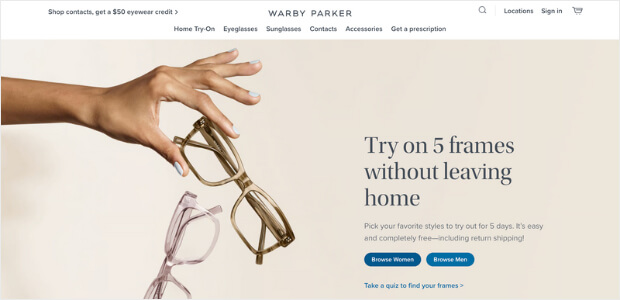
This approach disrupted the traditional eyewear market dominated by a few big players and gave Warby Parker a competitive advantage.
Here’s our step-by-step guide on How To Create a Buyer Persona to understand your target audience and tailor your marketing strategies accordingly.
2. Make Your Brand Stand Out
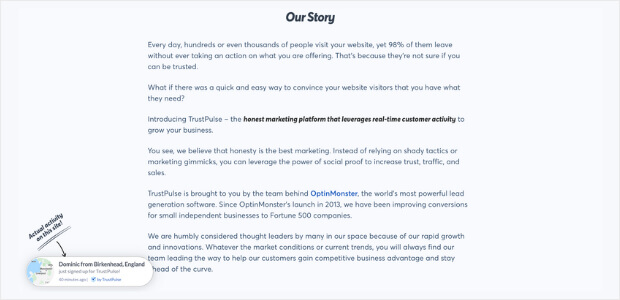
In a world where physical products can seem all too similar, how do you stand out? By showing what makes your brand and products one-of-a-kind.
Besides the step we’ve talked about earlier, here are some ways you can differentiate your eCommerce platform:
- Defining Your Brand Positioning: Brand positioning refers to how your brand is perceived in the marketplace. Define your brand positioning by identifying your USP, competitive advantages, and key differentiators. Your brand positioning should be tailored to your target audience and reflect your brand’s personality and values.
- Developing Your Brand Story: Your brand story is the narrative that explains who you are, what you stand for, and why you do what you do. Develop a compelling brand story that connects with your target audience and reflects your brand’s mission and values.
- Crafting Your Brand Messaging: Brand messaging includes your tagline, brand promise, and key benefits. Craft messaging that communicates the key benefits of your brand to your target audience. Focus on the benefits that your target audience cares about the most.
- Outlining Your Key Benefits: Outline the key benefits that your brand offers to your target audience. These benefits should be unique, relevant, and compelling. They should differentiate you from your competitors. Furthermore, they should provide a clear reason for your target audience to choose your brand over others.
Read our guide on How to Build a Brand People Love (and Trust)
3. Build a Strong Brand Identity
Your brand identity is how your customers will recognize and remember your business. It should give people something to connect with and remember as they interact with your brand, such as:
- Business name
- Logo design
- Typography (font style, appearance, structure, etc.)
- Color palette
- Brand voice (funny, sophisticated, authoritative, or friendly, depending on your industry and goals)
A great example of a brand with a strong eCommerce brand identity is Apple.
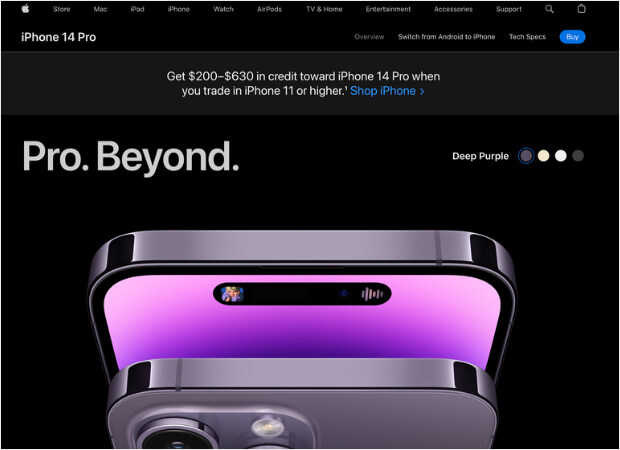
Apple’s brand values are all about simplicity, design, and innovation. As a result, most of their target audience includes tech-savvy individuals who appreciate high-quality products and value sleek design.
In addition, Apple’s brand personality is sophisticated, sleek, and modern, clearly reflected in its minimalist logo and design aesthetic. Their brand voice is concise and approachable, with a clear focus on the product and the user. And they have a comprehensive brand style guide that outlines their logo, colors, typography, and tone.
With a robust eCommerce brand identity, Apple has established itself as one of the world’s most valuable and iconic brands. Their loyal customer base and dominant market position in the technology industry speak to the effectiveness of their brand in creating exceptional user experiences.
4. Maintain Brand Consistency Throughout Your Business
Consistency is not just about using the same logo and color scheme across all your marketing materials. It’s about ensuring that every touchpoint with your brand delivers a consistent message and experience. Every aspect of your brand should reflect your unique value proposition and personality, from:
- your website design to your social media posts,
- product descriptions,
- and customer service interactions.
When your brand is consistent, your customers know what to expect from you, and they can trust that you’ll deliver on your promises. It also helps you stand out from your competitors and build a loyal following of customers who recognize and appreciate your brand.
One example of a popular brand that has demonstrated exceptional consistency is Coca-Cola.

For more than a century, Coca-Cola has remained true to its core values and delivered a memorable brand experience to its customers worldwide.
Through its iconic logo and brand colors to its signature taste and marketing campaigns, Coca-Cola has established a recognizable brand identity recognizable to millions of people. The brand has also maintained consistent messaging across all its marketing channels, including TV commercials, social media, and print advertising.
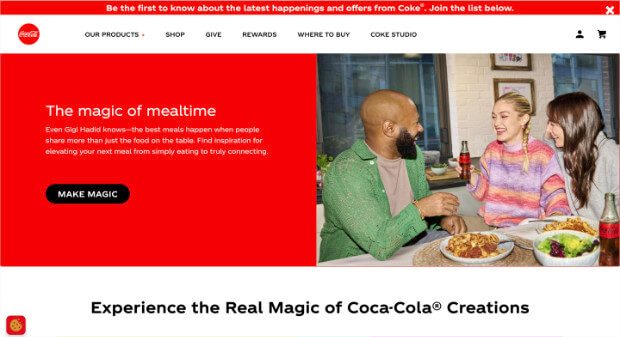
5. Deliver Quality Products
In the world of eCommerce, quality is everything.
Your customers expect to receive high-quality products that meet or exceed their expectations. If you fail to deliver on quality, your customers will quickly lose trust in your brand and look elsewhere for their needs.
Quality is not just about the physical product but also the entire customer experience. This includes the packaging, shipping, and customer service experience. Therefore, every touchpoint with your brand should reflect your commitment to quality and providing a positive customer experience.
By focusing on quality, you’ll build a loyal following of customers who trust and value your brand. These customers will become your brand ambassadors, spreading the word about your products and helping you grow your business over time. And, in the fiercely competitive world of eCommerce, that’s the key to long-term success.
An example of an eCommerce brand that started from zero but became a giant by delivering high-quality products is Shopify.
When Shopify was founded in 2004, it was a small online store selling snowboarding equipment. However, the company quickly realized that there was a significant opportunity to help other businesses create their own online stores, and they pivoted to become a leading eCommerce platform.
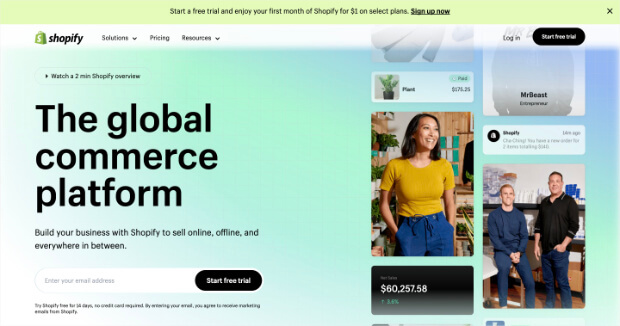
Shopify’s success can be attributed to many factors, but one of the most critical factors is its focus on delivering high-quality products and services to its customers. The company offers a user-friendly platform with features like customizable templates, payment processing, and inventory management.
Their commitment to quality has earned the trust and loyalty of millions of customers around the world. Due to this, as of 2023, Shopify is used by 4.15 million online stores and has a market cap of $56.63 billion.
Read our article on How To Sell Digital Products on Shopify.
6. Stay Updated With the Latest Trends
As the world of eCommerce continues to evolve rapidly, staying on top of the latest trends has become essential for businesses looking to build a successful online brand.
Whether you’re just starting or have been in the game for a while, keeping up with what’s hot and what’s not is crucial. It can make all the difference in your ability to connect with your audience, stand out from the competition, and drive sales.
Of course, it isn’t just about being aware of what’s happening in the industry. It’s also about taking action to use those trends for the benefit of your online business.
For example, if you notice that video content is becoming increasingly popular, consider incorporating more videos into your marketing strategy. Or, if you see that more and more customers are shopping on mobile devices, make sure your website is optimized for mobile.
Must check out some of the other top eCommerce trends you should know to stay relevant in the eCommerce industry and boost your eCommerce sales.
7. Diversify Your Content
Not everyone likes to consume content in the same way. Some people prefer to read blog posts, while others like to watch videos or listen to podcasts. That’s why you should focus on creating helpful and diverse content related to your niche.
TrustPulse, for example, has an entire section on its site featuring eCommerce content.
Let’s take a look at some high-converting content types you can create for your eCommerce brand:
- Blog posts: Write about a wide range of topics, such as product reviews, how-to guides, industry news, and comparison content.
- Videos: Create product demos, explainer videos, and even vlogs to give your audience a behind-the-scenes look at your business.
- Podcasts: You can also interview industry experts, share your own insights and experiences, and provide valuable advice to your listeners.
- Infographics: Break down complex information into digestible chunks with infographics to stand out in a crowded online space.
Creating various content types allows you to appeal to different learning styles and preferences. Plus, it can help you reach new audiences and increase your brand’s visibility online. So, feel free to experiment with different types of content and see what resonates with your audience.
Also, products on the first page of search engine results have much higher clickthrough rates and sales. So don’t forget to take your time to improve your eCommerce SEO to rank higher.
If you want to learn more about content marketing, these articles might be helpful:
- Ultimate Beginner’s Guide to Content Marketing
- Impressive Content Marketing Examples You Can Use
- Steps to Create a Content Marketing Strategy to Grow Your Business
- Content Formats Proven to Boost Audience Engagement
8. Leverage Social Media
Nowadays, social media has become an indispensable tool for businesses to connect with their audience. As an eCommerce brand, leveraging social media platforms can be a game-changer in gaining visibility, increasing sales, and building a loyal customer base.
The key to successfully leveraging social media for your eCommerce brand is to approach it strategically. You don’t want to just start posting random content and hoping for the best. Instead, you should have a clear plan in place.
First, you need to figure out which social media platforms your target audience is most active on. Are they primarily using Instagram? Facebook? Twitter? LinkedIn? Once you have that information, you can start creating content tailored specifically to each platform.
For example:
- Suppose your target audience is mostly on Instagram. In that case, you’ll want to focus on creating visually engaging content that showcases your products in a creative way. If you have a small business and just starting out, collaborate with influencers who have a large following and influence over their audience. You can leverage their reach and credibility to promote your products or services.
H&M is one of the brands with a large following on Instagram, with over 38.2 million followers as of May 2023. Their Instagram features a variety of content, including fashion collections, sustainability initiatives, and user-generated content.
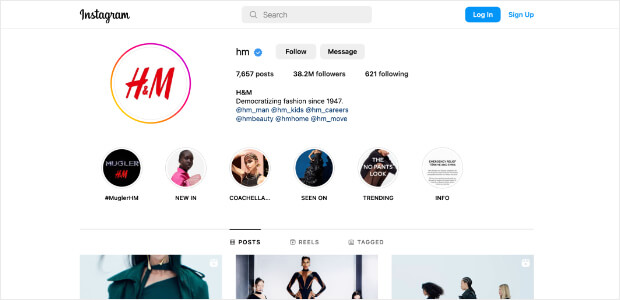
- On Facebook, you might want to focus more on sharing helpful blog posts and articles related to your industry, along with product updates and promotions. Additionally, you can utilize Facebook ads to showcase your products or services to your target audience.
Another key element of leveraging social media for your eCommerce brand is engaging with your audience. Don’t just post content and forget about it. Respond to comments and messages, and create opportunities for your followers to engage with you. It can be through many ways, such as giveaways or contests.
RafflePress is the best giveaway plugin for WordPress.
This powerful tool allows you to easily create and run giveaways and contests to drive traffic, boost engagement, and generate sales for your online store.
You can create various promotional campaigns, from simple giveaways to more complex contests with multiple entry options. It can even allow you to integrate your campaigns with popular email marketing and social media platforms to reach a wider audience.
And the best part? RafflePress is incredibly user-friendly, even for those who are not tech-savvy.
With its intuitive drag-and-drop builder, you can create stunning campaigns in just a few clicks. Plus, with its robust analytics and tracking tools, you can monitor your campaign’s performance and tweak your results.
Check out the Best WordPress Contest Plugins for Boosting Engagement.
9. Take Advantage of Social Proof
Picture this:
You’re browsing an online store, and you come across a product that catches your eye. You’re not sure if it’s worth buying, but then you notice that it has hundreds of five-star reviews from happy customers. Suddenly, your decision becomes much easier. You’re more likely to trust that this product is worth buying because other people have already had a positive experience with it.
That’s the power of social proof, and it’s a crucial element in building a successful eCommerce brand.
Social proof is all about using the influence of others to build credibility and trust with your target audience. By showcasing positive reviews, ratings, and testimonials from real customers, you can increase the likelihood that others will see your brand as trustworthy and reliable.
But how can you ensure you’re taking full advantage of social proof?
One powerful tool you can use is TrustPulse.
TrustPulse is the #1 social proof plugin. It lets you display real-time notifications of recent customer activity on your website. For example, you’ll be able to show small pop-ups the instant someone takes action on your site, like:
- Making a purchase,
- Signing up for your email list,
- Giving reviews
These notifications help create a sense of urgency and FOMO (fear of missing out) for potential customers, encouraging them to take action and purchase. Most importantly, when potential customers see these notifications, they’re more likely to trust you and take action themselves.

This is one of the most effortless ways to get started with social proof because you’re taking advantage of the traffic you already have.
And if you want to display reviews from third-party sites, you can connect to Zapier and capture user activity from thousands of apps. You can even show reviews from Google Reviews or Yelp.
However, TrustPulse isn’t just for eCommerce sites. It can be used on any website to increase conversions and establish trust. For example, if you run a SaaS company, you can use TrustPulse to show when other people have signed up for your new product or upgraded to a paid plan.
The best part is that you don’t need coding skills or technical experience. It’s super easy to set up, design, and launch social proof notifications.
In fact, these popup notifications have been shown to boost conversion rates by up to 15%.
Check out some more articles related to social proof:
- Social Proof Examples To Start Using Today
- Social Proof: Free Tips for Social Proof Marketing Inside
- Best Social Proof Tools To Boost Your Conversions
- REVEALED: Reasons to Avoid Fake Social Proof
10. Offer Exceptional Customer Service

In today’s competitive market, customers have plenty of options to choose from. And one bad experience can easily send them to your competitors. That’s why providing excellent customer service is vital for building trust and loyalty with your customers.
But exceptional customer service doesn’t just mean being polite and friendly (although that’s a good start). It means going above and beyond to meet your customers’ needs and exceed their expectations. It means being responsive and helpful when they have questions or concerns and ensuring they feel valued and appreciated.
You need to listen to their feedback and respond to their queries promptly. Make sure you have multiple channels available for customer support, including email, phone, and live chat. In this way, customers can reach out to you in their preferred way.
In addition to being responsive, your customer service team should be knowledgeable and friendly. They should have a thorough understanding of your products and be able to assist customers in finding the right product for their needs.
Finally, don’t forget to go above and beyond to delight your customers. You can offer personalized recommendations, surprise them with a small gift or discount, or thank them for their loyalty. These little touches can make a big difference and help you stand out from the competition.
Some other tips for offering exceptional customer service include:
- Respond quickly and professionally to customer inquiries and concerns.
- Personalize your interactions with customers, using their names and addressing their specific needs.
- Be transparent and honest with customers about any issues that may arise.
- Provide fast and reliable shipping and delivery.
- Offer a hassle-free return and exchange policy.
Also check out:
Build a Distinctive eCommerce Brand for Online Success
And that’s it!
Branding is important for the success of your online store. When you work on your brand and make it a good experience for customers, people will like it and talk about it to others. This can create a community of people who love your brand and want to support it.
By following the steps outlined in this article, you can create a loyal customer base and increase profits.
However, it’s important to remember that building a successful eCommerce brand is an ongoing process. It requires continuous improvements to stay ahead of the competition and meet your customers’ needs.
With dedication, creativity, and a commitment to providing value to customers, you can build a thriving eCommerce business.
Check out the Best eCommerce Marketing Automation Software to boost your online business.
If you’re yet to create a website for your new eCommerce business, learn How to Make a Small Business Website in 6 Easy Steps.
Want to get started with social proof on your eCommerce site? Try TrustPulse risk-free today!

